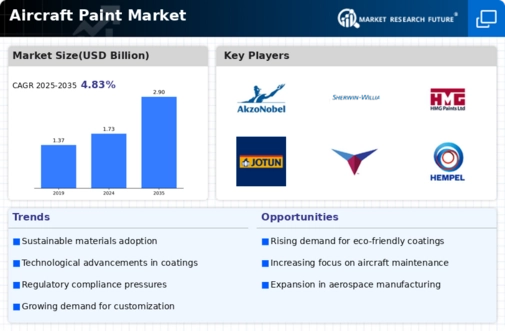Market Growth Projections
The Global Aircraft Paint Market Industry is poised for substantial growth, with projections indicating a market value of 2.9 USD Billion by 2035. This anticipated growth reflects a compound annual growth rate (CAGR) of 4.82% from 2025 to 2035. Various factors contribute to this upward trajectory, including advancements in technology, increasing regulatory requirements, and the expansion of the aviation sector. As the industry evolves, stakeholders must remain vigilant in adapting to changing market dynamics and consumer preferences. The future of the aircraft paint market appears promising, driven by a combination of innovation, compliance, and the ongoing expansion of global air travel.
Expansion of the Aviation Sector
The expansion of the global aviation sector serves as a critical driver for the Global Aircraft Paint Market Industry. With increasing air travel demand, airlines are expanding their fleets, leading to a higher requirement for aircraft paint. This growth is particularly evident in emerging markets, where new airlines are entering the market and existing operators are upgrading their fleets. As the market is projected to reach 2.9 USD Billion by 2035, the expansion of the aviation sector is expected to fuel the demand for aircraft paint significantly. This trend underscores the importance of the aviation industry's growth in shaping the future landscape of aircraft paint.
Rising Focus on Aesthetic Appeal
The Global Aircraft Paint Market Industry is also driven by a rising focus on the aesthetic appeal of aircraft. Airlines increasingly recognize the importance of branding and visual identity, leading to a demand for custom paint jobs and unique designs. This trend not only enhances the airline's image but also attracts passengers. As airlines invest in their fleet's appearance, the demand for high-quality, durable, and visually appealing paints rises. This emphasis on aesthetics, combined with the need for functionality, creates a dynamic market environment where manufacturers must balance performance with design, further propelling the growth of the aircraft paint sector.
Technological Advancements in Coatings
Innovations in coating technologies significantly influence the Global Aircraft Paint Market Industry. The introduction of advanced materials, such as nanotechnology-based paints, enhances durability and reduces weight, which is crucial for fuel efficiency. These advancements not only improve the performance of aircraft paints but also align with the industry's sustainability goals. As airlines increasingly prioritize eco-friendly solutions, the demand for low-VOC and high-performance coatings rises. This shift towards innovative technologies is projected to contribute to the market's growth, with an anticipated CAGR of 4.82% from 2025 to 2035, indicating a robust future for technologically advanced aircraft paints.
Growing Demand for Aircraft Maintenance
The Global Aircraft Paint Market Industry experiences a notable increase in demand driven by the rising need for aircraft maintenance and refurbishment. As airlines and operators focus on maintaining their fleets, the application of high-quality paint becomes essential to protect against corrosion and wear. In 2024, the market is valued at approximately 1.73 USD Billion, reflecting the industry's growth trajectory. This trend is expected to continue, as the global fleet expands and older aircraft undergo repainting to meet regulatory standards and aesthetic preferences. Consequently, the maintenance sector plays a pivotal role in shaping the demand for aircraft paint.
Regulatory Compliance and Safety Standards
The Global Aircraft Paint Market Industry is significantly influenced by stringent regulatory compliance and safety standards imposed by aviation authorities. These regulations dictate the types of materials and processes that can be used in aircraft painting, ensuring safety and environmental protection. As regulations evolve, manufacturers are compelled to innovate and adapt their products to meet these requirements. This compliance not only enhances the safety of aircraft but also drives the demand for specialized paints that adhere to these standards. Consequently, the focus on regulatory compliance is a key driver of market growth, as it necessitates the continuous development of new and improved aircraft paint solutions.












